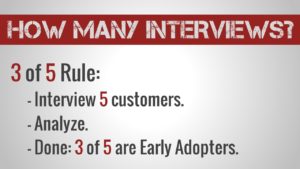
So we want to ask customers if they’ll pay for Bounce before we build it, but first we need to figure out who they are.
Step 1 – What problem do we solve?
Since people don’t buy products, they buy solutions to problems, we started by identifying the problem we solve:
Being late is stressful. Bounce eliminates that stress by making it easy to be on time.
Step 2 – Who has the problem we’re solving?
Anyone who doesn’t like being late.
Step 3 – How will we tell people with this problem about our solution?
Hmm…now we’ve got a problem.
No one identifies with the customer segment we’ve called out here. No one joins the, “People who don’t like being late” group on LinkedIn. No one reads ThePunctualityBlog.com. As we learned with OnCompare, if there’s no way for us to interact with these people, they’re not a customer segment.
Step 2 (again) – Who has the problem we’re solving?
Who has lots of meetings outside their office as part of their job?
Real Estate agents, sales people, event planners, founders, general contractors, etc.
What kind of companies “sell” being on time?
Florists, caterers, utility installers/repairers, plumbers, electricians, etc.
Who is routinely affected by bad traffic?
Long distance commuters, van pools, people who commute over a bridge, etc.
Who really wants to be on time for their personal life?
Single people who are dating, busy parents, the “chronically late”.
Who is unfamiliar with the local traffic patterns?
Business travelers, people who have just moved to an area.
Step 3 – How will we tell people with this problem about our solution?
Almost all of the customers above self-organize into groups. Either actual LinkedIn, Meetup or trade groups, or they’ve formed ad hoc communities on blogs or forums. Or perhaps, they have a common set of suppliers, or they advertise in the same set of magazines. For example:
- Real Estate Agents – LinkedIn, meetup, trade group, blogs and forums
- Florists – trade groups, all interact with FTD, all interact with wedding planners
- Bridge commuters – listen to the radio, subscribe to traffic twitter feeds, download traffic apps
- People who have just moved to an area – read hyperlocal blogs, new college students read college newspapers
Etc.
Step 4 – Identify the Influencers
Now that we know the groups our customers hang out in, we need to identify the influencers of those groups. For blogs that means finding the authors, for meetup and linked in groups it’s finding the moderators, if we need press it’s finding the person who is going to write our story, etc.
Of course, we need more than their name, we need at least their email address. To find that info for every one of our influencers requires hours and hours of tedious net-scouring, and to be perfectly honest, I hate don’t enjoy it.
 Luckily, my friend Marcos Polanco introduced me to oDesk – a fantastic resource for internet research. The idea is simple, pay someone else $5/hr to do the tedious work. I write up detailed instructions on how to find someone’s email address including things like:
Luckily, my friend Marcos Polanco introduced me to oDesk – a fantastic resource for internet research. The idea is simple, pay someone else $5/hr to do the tedious work. I write up detailed instructions on how to find someone’s email address including things like:
- Do google searches for:
- Use www.Jigsaw.com (which is good advice for everyone, btw)
And then I tell them to “Find the contact info of the top 5 hyperlocal bloggers in each of these cities: Los Angeles, New York, Chicago, San Francisco and Seattle.”
5 hours, and $25 later, I’ve got 25 email address. So much better than me doing it myself.
Step 5 – Provide Value
Now that we’ve got our influencers’ contact information, it’s time to reach out. Of course sending a, “You should tell your group about my awesome product!” email isn’t going to work. If we’re going to get anywhere with influencers, we need to provide them and their group value.
Hey [local blogger name],
I saw your article on how awful traffic is getting in Chicago [link to article]. A friend and I are launching a Kickstarter project [link] to build an app that makes getting around Chicago easier – despite worsening traffic.
Think [blog name] readers would be interested in something like that?”
When I’ve done this before I’ve pitched the actual product, not a Kickstarter project to fund the product, so I’m not sure what kind of reaction we’ll get. Either way, we’ll use FollowUpThen to bug them about it at least one more time. ;)
To Recap
Those are the 5 steps we’re using to identify, segment and contact our customers:
- What problem are we solving?
- Who has that problem?
- How will we tell people with this problem about our solution?
- Identify influencers
- Provide value
I’ll keep you posted on how it works out. In the meantime, alterations or alternatives to this approach are welcome.





Awesome, looking forward to the results. You should check out using UX personas to zoom in on your customer segment. A few good articles at LUXr.co or on Cooper’s blog.
Excellently executed. Glad to have share a tip!